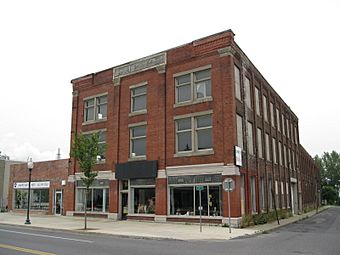Joubert and White Building facts for kids
Quick facts for kids |
|
|
Joubert and White Building
|
|

Joubert and White Building, August 2009
|
|
| Location | 77-79 Warren St., Glens Falls, New York |
|---|---|
| Area | 1 acre (0.40 ha) |
| Built | 1864 |
| MPS | Glens Falls MRA |
| NRHP reference No. | 84003360 |
| Added to NRHP | September 29, 1984 |
The Joubert and White Building is a historic building in Glens Falls, New York. You can find it at 77-79 Warren Street. This building was once the main office and factory for the Joubert and White Company. They were famous for making special horse-drawn carriages called buckboards.
The building is made of brick and has three stories. It has a flat roof and a strong foundation of cut limestone. Because of its history, the Joubert and White Building was added to the National Register of Historic Places in 1984. This means it is an important place worth protecting.
Contents
Building a Business: The Start of Joubert and White
In 1864, two friends, Edward Joubert and J. Huyler White, decided to start a business. They borrowed $50, which was a lot of money back then! They used this money to build a large factory. This factory was about 18,000 square feet in size.
The factory was located at what is now 77-79 Warren Street. It had a big area for making things. There was also a second building on Jay Street for storing finished carriages. They even had a lumberyard where wood was kept until it was ready to use.
The Famous Joubert and White Company
The Joubert and White Company began making high-quality buckboards in 1865. They became known for inventing a special type of buckboard. This carriage had a unique suspension system. It made the ride much smoother than other buckboards.
Many rich and famous people wanted these special carriages. Some owners included Cornelius Vanderbilt, John Jacob Astor, and Andrew Carnegie. Even John D. Rockefeller owned one!
What Made Their Buckboards Special?
Regular buckboards had two wooden planks between the front and back wheels. The passenger seat sat right on these planks. This meant the only thing soaking up bumps was the wood itself. Riding on rough roads felt like riding a "bucking horse," which is how they got their name.
Edward Joubert came up with a clever idea. He added two steel leaf springs to the planks. These springs curved upwards, and the seat was attached to them. This design allowed the seats to move up and down, and even rock a little. It made the ride much more comfortable. Joubert even got a patent for his invention in 1880.
The company made about 50 different models of carriages and sleighs. All of them were known for their excellent quality. A regular buggy might cost $50 to $75. But a Joubert and White buckboard could cost $500 to $800. Some custom ones even sold for $1000 or more!
Growing and Changing Times
By 1897, the company had 35 employees. They made about 75 vehicles each year and had sales of $50,000. Edward Joubert managed the factory and how things were made. He passed away in 1890.
J. Huyler White handled the sales. He kept the business going and traveled across the country. People called him the "Buckboard King." He took orders through catalogs. The company kept making buckboards into the early 1900s.
However, things changed when gasoline-powered automobiles became popular. People started buying cars instead of horse-drawn carriages. When White died in 1916, the company closed down. Its assets, worth $100,000, were shared among the families of Joubert and White.
The Empire Automobile Company Moves In
After the buckboard company, the Joubert and White Building found a new purpose. Starting in 1910, it became home to the Empire Automobile Company. This company was owned by D.H. Cowles and Frank M. Starbuck.
They served wealthy people visiting the Saratoga Springs, New York and Adirondack Mountains areas. Many rich tourists traveled by car. Cowles and Starbuck offered a place to store and repair these automobiles. Visitors could have their cars serviced overnight. This was very helpful before they continued their journey into the Adirondacks.
In 1933, Empire Automotive started sharing its space. Another car dealership, Comac Sales, Inc., moved in. Empire Auto stayed in business until 1935. They sold popular car brands like Chevrolet, Cadillac, and Hudson. They also sold GMC trucks.
A New Chapter: Decline and Renovation
After Empire Automobile Company closed, Comac Sales, Inc. took over the building. They were a Chevrolet dealer. They stayed there until 1956. Then, the building changed owners and became Whiteman Chevrolet. Whiteman Chevrolet moved to a new location in 1957.
The Joubert and White Building was empty for a few years. In 1960, Campbell Wholesale Plumbing and Heating Corporation moved in. After Campbell closed in 1970, many different businesses used the building. These included a candle shop, an auto parts store, and a tax preparation office. There was even a martial arts studio!
By 2008, the building was mostly used as a warehouse. But in 2011, it got a big makeover! The building was renovated and now has both shops and apartments. It is now known as Warren Street Square, starting a new chapter in its long history.



